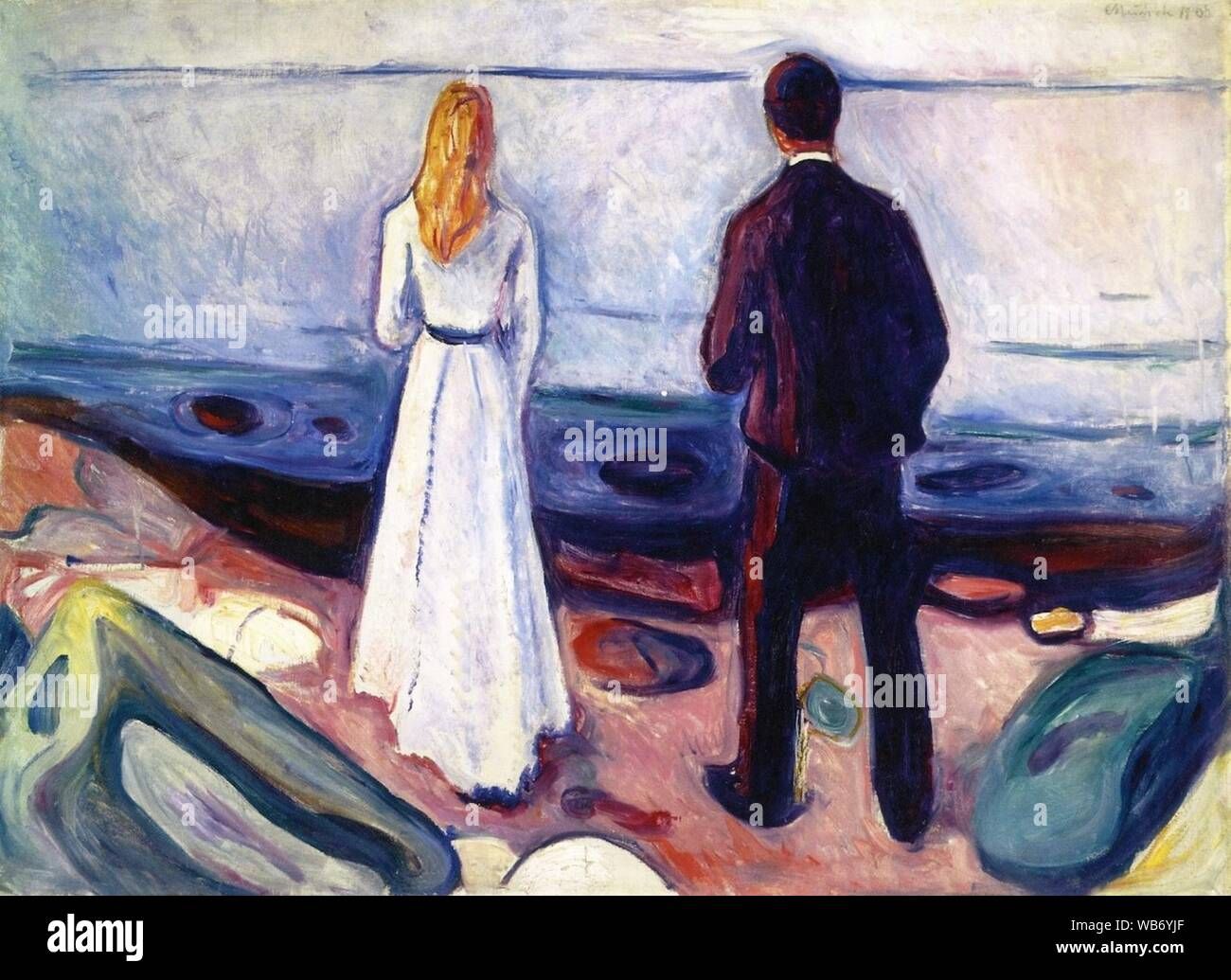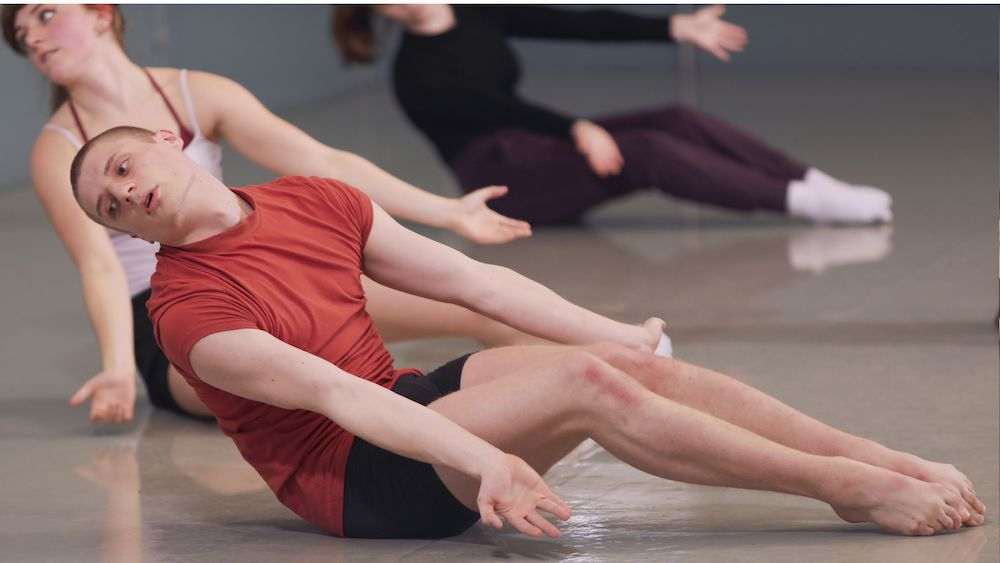Edvard Munch’s masterpiece, “Two Human Beings (The Lonely Ones),” encapsulates the essence of human connection and isolation, as it showcases a man and a woman standing by the shore. Painted between 1906 and 1908, this iconic work exemplifies Munch’s deep exploration of loneliness and companionship, making it a pivotal piece within the broader scope of Edvard Munch art. This painting is part of a broader Munch exhibition at Harvard that examines the artist’s 40-year fixation with this motif, revealing his unique ability to blend emotions through varied artistic techniques. Notably, Munch, a groundbreaking Modernist painter, emphasized the interplay between figures and landscapes, leaving viewers enchanted and contemplative. Through insightful art analysis, we uncover how Munch’s trial of colors and forms in “The Lonely Ones” resonates with themes that transcend mere isolation, urging us to reflect on deeper connections.
In the realm of art, Edvard Munch’s “Two Human Beings”—also known as “The Lonely Ones”—stands as a testament to his preoccupation with the emotional landscape of relationships. This significant work, showcased in the recent Munch exhibition at Harvard, invites audiences to delve into the complex dynamics of companionship and solitude through its symbolic representation of human figures on a desolate shore. As a prominent Modernist artist, Munch’s approach integrates various painting techniques, offering rich layers for art analysis. The subtle interactions between the figures not only depict isolation but also hint at an intimate connection that transcends verbal communication, encouraging viewers to consider the nuances of human relations. Munch’s work continues to captivate and inspire, blending personal emotion with universal themes that resonate across time.
Exploring Edvard Munch’s Artistic Obsession
Edvard Munch’s enduring fascination with the motif of ‘Two Human Beings (The Lonely Ones)’ captures the essence of his artistic journey. Over a span of forty years, Munch revisited this theme, showcasing a man and a woman standing at the shoreline, often depicted in various colors and styles. This recurrence raises intriguing questions about Munch’s artistic intent. Was he simply obsessed with depicting loneliness, or was there a deeper exploration of human connection at play? In each version, subtle shifts in color and brush technique suggest a dynamic relationship between the figures, hinting at a broader narrative surrounding companionship and isolation.
Art analysts have long examined Munch’s various representations of these figures, particularly in the context of his larger body of work. By consistently revisiting the shoreline motif, Munch not only documented the evolving nuances of his own emotional landscape but also engaged with broader themes relevant to the Modernist movement. Each iteration presents an opportunity for Munch to refine his technique, explore color theory, and challenge conventions of narrative in art, making him a pivotal figure in the art world and a modernist painter who transformed how we perceive human relationships in the visual arts.
The Symbolism of The Lonely Ones in Munch’s Work
The painting ‘Two Human Beings (The Lonely Ones)’ has long been interpreted as a commentary on isolation, evoking feelings of loneliness even in the presence of another. However, curator Lynette Roth proposes a reevaluation of this interpretation. After studying Munch’s diverse iterations, she suggests that these figures may not embody loneliness but rather a profound connection to each other and their environment. The colors and the manner in which the figures are composed allow for contemplation and companionship, challenging the traditional view that art must always reflect despair. Munch’s strategic use of color works as a psychological bridge between the figures, suggesting a connection rather than a divide.
Munch’s depictions can be seen as a dialogue between solitude and unity, as he navigates the complexity of human emotions. This interplay invites viewers to consider the subtleties present in human relationships, where isolation coexists with shared experience. His illustrations, particularly in ‘Two Human Beings,’ demonstrate that the experience of being together can hold multifaceted meanings, symbolizing both emotional closeness and the spaciousness of independent identity. As the curatorial narrative of ‘Edvard Munch: Technically Speaking’ unfolds, it becomes clear that Munch was not merely a chronicler of loneliness but an architect of deeper human connections.
Technique and Innovation in Munch’s Prints and Paintings
Munch’s innovative approach to printmaking distinctly complements his paintings, as seen in his renditions of ‘Two Human Beings.’ His technique involved breaking the motif down into various components, akin to a puzzle. By utilizing a jigsaw method, each element was carved separately and inked individually, allowing for a mesmerizing variety of color and texture in his prints. This method reflects Munch’s desire to explore imperfections in art, showcasing that sometimes the flaws can heighten the emotional intensity of the piece. In contrast to the polished works of his contemporaries, Munch embraced the irregularities, inviting viewers to appreciate the raw energy within his creations.
The dynamism in Munch’s technique resonates deeply in his visual storytelling. For example, the momentary gestures and thick brush strokes in his later paintings provide a sense of spontaneity that echoes the emotions encapsulated in his prints. This synesthetic approach to art merges the tactile qualities of paint with the emotional depth captured in printmaking, a duality that establishes Munch as a modernist pioneer. His ability to blend different mediums effectively illustrates a complex narrative that speaks to both personal and universal themes, further solidifying his influence within the realm of art analysis and criticism.
Revisiting Munch: The Cultural Legacy of Two Human Beings
The legacy of ‘Two Human Beings’ continues to evolve in contemporary discussions about art and culture. Munch’s ability to convey deep emotional narratives through seemingly simple motifs has made his work a focal point for both art connoisseurs and casual viewers alike. The exploration of human isolation, connection, and the complexities of coexistence resonates with audiences across generations, sparking dialogues about the nature of relationships in our modern world. As society grapples with heightened feelings of loneliness, particularly during times of crisis, Munch’s work invites reflection on the significance of companionship.
Moreover, exhibitions like ‘Edvard Munch: Technically Speaking’ at the Harvard Art Museums play a crucial role in recontextualizing Munch’s art within a contemporary landscape. By showcasing a broad spectrum of his works, these exhibitions challenge traditional interpretations of his motifs, opening up discussions regarding emotional depth and the multifaceted nature of human experience. Art analysts and historians increasingly recognize Munch’s contributions not merely as reflections of personal torment but as powerful examinations of the human condition, making his work relevant to today’s discourse on mental health, connection, and emotional authenticity.
The Influence of Modernism on Edvard Munch’s Art
Edvard Munch stands as a pivotal figure in the Modernist movement, influencing countless artists with his exploration of emotional depth and psychological complexity. His approach to themes such as love, anxiety, and sadness was revolutionary, moving away from the representational realism that dominated earlier art. Munch encapsulated the modern experience, using bold colors and innovative techniques to express feelings often deemed too intimate for public display. Paintings like ‘Two Human Beings (The Lonely Ones)’ exemplify this shift, as Munch navigates the intricacies of emotional relationships while employing non-traditional methods.
The impact of Munch’s work can be seen in the ways contemporary artists approach similar themes. His willingness to explore darker aspects of the human psyche has paved the way for future generations to express vulnerability and fear, pushing boundaries within the art world. By incorporating autobiographical elements and abstract symbolism, Munch inspired a culture of experimentation, infusing art with psychological depth and inviting audiences to engage with their own emotional narratives. His legacy as a Modernist painter lies not only in his subject matter but also in his radical approach to form and color, which continues to influence art analysis today.
Art Analysis of Munch’s Use of Color
Color plays a fundamental role in Edvard Munch’s art, serving as a visual language that conveys emotional nuances. In ‘Two Human Beings (The Lonely Ones)’, the deliberate use of color variations transforms the characters and their surroundings, emphasizing their psychological states. Munch’s choice of a subdued palette in some iterations evokes feelings of melancholy, while more vibrant hues in others suggest hope and connection. This fluidity in color not only encapsulates the emotional landscape of the figures but also mirrors Munch’s own journey as an artist, allowing him to express the complexities of human emotions profoundly.
This intricate use of color reflects Munch’s understanding of psychological dynamics and his embodiment of Modernist principles. By strategically incorporating different color schemes into his work, he invites viewers to engage with the emotional resonance of each piece. The colors serve as a bridge, drawing connections between the figures and their environment, making the ordinary scene of a couple at the shoreline a poignant exploration of companionship and solitude. Art analysis within this framework reveals not just Munch’s technical abilities but also his keen insight into the emotional experience of being human.
The Role of Landscape in Munch’s Artistic Expression
In ‘Two Human Beings (The Lonely Ones)’, the landscape plays a significant role in shaping the narrative, acting not merely as a backdrop but as a vital entity in the composition. Munch often infused his landscapes with emotional weight, using them to reflect the inner states of his characters. This approach illustrates a profound interconnectedness between the figures and the environment, highlighting the theme of human isolation amidst beauty. By situating his characters at the water’s edge, Munch effectively emphasizes the tension between connection and alienation, inviting viewers to contemplate their relationship with both the figures and the surrounding landscape.
The shoreline, as depicted by Munch, serves as a liminal space where the forces of nature meet the human condition. His portrayal reminds us that landscapes are not static; they are dynamic and imbued with emotional capacity. This focus on the interaction between figures and nature reflects Munch’s broader exploration of the human experience, marrying existential inquiry with the study of the physical world. The landscape, therefore, becomes another character in Munch’s narrative, highlighting the profound dialogue between humanity and nature that continues to resonate in modern art discussions.
Munch’s Contribution to Printmaking as an Art Form
Edvard Munch’s contributions to printmaking ensure his place in art history, as he pioneered techniques that expanded the possibilities of artistic expression. In works like ‘Two Human Beings’, Munch utilized printmaking methods to deconstruct the traditional boundaries of painting. His jigsaw approach not only created varied interpretations but also demonstrated that printmaking could convey just as much emotional depth as painting. This innovation challenged pre-existing norms and positioned printmaking as a respected art form capable of intricate storytelling and emotional resonance.
Moreover, Munch’s unique techniques in printmaking, characterized by his embrace of imperfections and variations, reflect a deeper philosophical understanding of art and its creation. He believed that the flaws in a work could evoke more profound emotional responses than meticulously polished pieces. By encouraging viewers to appreciate the unexpected, Munch reshaped art sensitivity towards print media, allowing for broader acceptance of artistic experimentation. His legacy in printmaking endures, as contemporary artists continue to draw inspiration from his innovative practices and emotional storytelling.
Munch’s Psychological Exploration Through Art
Edvard Munch’s artwork, especially ‘Two Human Beings,’ serves as a window into his psychological explorations. Often referencing his own emotional experiences, Munch examined themes of love, anxiety, and existential despair. Rather than using his art solely as an outlet for personal pain, he transcended his experiences to delve into the shared human condition, inviting viewers to reflect on their emotional landscapes. Munch’s psychological complexity enriches the narratives within his works, providing layers of meaning that resonate with audiences.
This approach encourages a critical examination of how mental health and art intersect. Munch’s signature style incorporates raw emotion and psychological insight, which enhances the viewer’s connection to the artwork. By portraying vulnerability through his characters, especially within motifs like ‘The Lonely Ones,’ Munch articulates experiences that are often overlooked, fostering empathy and understanding. As a result, his work remains relevant today, contributing to conversations about mental health and the importance of emotional expression in society.
Frequently Asked Questions
What are the key themes explored in Edvard Munch’s ‘Two Human Beings (The Lonely Ones)’?
Edvard Munch’s ‘Two Human Beings (The Lonely Ones)’ intricately explores themes of isolation and companionship. The painting features a man and woman standing together yet apart, symbolizing emotional distance. This recurrent motif highlights the dynamic between solitude and connection, suggesting that even in company, individuals may feel isolated. The ongoing interpretation of this work continues to resonate with audiences seeking to understand human relationships.
How did Edvard Munch’s ‘Two Human Beings’ evolve throughout his career?
Over his 40-year career, Edvard Munch revisited ‘Two Human Beings (The Lonely Ones)’ in various forms, including paintings and prints. Each version reflects different techniques and emotions, showcasing his creative evolution. From the original painted in the early 1890s to later renditions around 1906-1908 and eventually to a more spontaneous version in the 1930s, Munch’s exploration of this motif demonstrates his adaptability and artistic growth.
What can visitors expect to see at the Munch exhibition at Harvard Art Museums?
The ‘Edvard Munch: Technically Speaking’ exhibition at Harvard Art Museums features over 70 works, primarily from the museum’s collection. Visitors can explore various iterations of ‘Two Human Beings (The Lonely Ones)’ alongside other significant pieces. The exhibition emphasizes Munch’s innovative techniques, including printmaking and painting, and encourages a deeper understanding of his artistic process, separate from his personal struggles.
How does Edvard Munch’s technique in ‘Two Human Beings’ reflect modern artistic practices?
Munch’s technique in ‘Two Human Beings (The Lonely Ones)’ showcases a modernist approach by embracing imperfections and dynamic brushwork. He often left sections of the canvas unpainted or applied paint unevenly, creating a sense of movement and vibrancy. This method contrasts with traditional fine art polish and aligns more closely with contemporary priorities of expression and emotional depth in art, making Munch a pioneering figure in modernism.
What is the significance of Munch’s title ‘The Lonely Ones’ in relation to ‘Two Human Beings’?
The title ‘The Lonely Ones’ reflects the deep sense of isolation inherent in Edvard Munch’s ‘Two Human Beings.’ Although originally focusing on companionship, the title underscores the emotional complexities between the figures and the landscape. It challenges viewers to reconsider loneliness and connection, suggesting a narrative where presence does not equate to emotional intimacy, inviting diverse interpretations of their relationship.
In what ways did Edvard Munch integrate printmaking into his depiction of ‘Two Human Beings’?
Edvard Munch utilized printmaking techniques to reinterpret ‘Two Human Beings,’ employing a jigsaw method for his woodblock prints. By separating components of the figures and inking them individually, he created numerous variations of color and composition. This approach allowed Munch to experiment with the motif’s emotional depth and visual impact, revealing a complex interplay between his printed and painted works.
What impact did Edvard Munch’s work have on modern art?
Edvard Munch’s work, particularly pieces like ‘Two Human Beings (The Lonely Ones),’ significantly impacted modern art by pioneering emotional expression and psychological depth. His exploration of themes such as solitude, anxiety, and the human condition paved the way for future artists to engage with similar topics. As a modernist painter, Munch’s innovative techniques and bold colors influenced movements like Expressionism, leaving a lasting legacy.
What are some notable characteristics of Edvard Munch’s painting style in ‘The Lonely Ones’?
Edvard Munch’s painting style in ‘Two Human Beings (The Lonely Ones)’ is characterized by a blend of emotional intensity and innovative techniques. He often employed vibrant colors and dynamic brushstrokes while leaving parts of the canvas exposed, creating a sense of movement and life within the artwork. This approach encapsulates the exploration of modernist themes, emphasizing emotional resonance over conventional aesthetic polish.
What does Edvard Munch’s artistic process tell us about his work, particularly ‘Two Human Beings’?
Munch’s artistic process, especially seen in ‘Two Human Beings (The Lonely Ones),’ reveals his experimental nature and willingness to push boundaries. He often revisited themes, incorporating different techniques and materials that reflected his evolving ideas on art and emotion. This iterative approach demonstrates Munch’s desire to explore the depths of human experience through his artistic expression, making his works rich for analysis and discussion.
| Aspect | Details |
|---|---|
| Title | Two Human Beings (The Lonely Ones) |
| Artist | Edvard Munch (1863-1944) |
| Exhibition | Edvard Munch: Technically Speaking, Harvard Art Museums |
| Medium | Oil on canvas |
| Year Created | 1906–8 (with earlier versions dating back to 1892) |
| Themes | Isolation, companionship, artistic exploration |
| Technique | Varied painting techniques, color explorations, integration of figures |
| Exhibition Duration | Through July 27, 2025 |
Summary
Edvard Munch’s “Two Human Beings” captures the complexity of human connection and isolation, compelling viewers to explore the intricate relationship between the figures depicted on the shoreline. This artwork delves into themes of companionship and contemplation, challenging the initial interpretations of solitude. Through various iterations over 40 years, Munch transforms these figures into a reflection of profound emotional depth, allowing the audience to engage with the layered meanings embedded in each brushstroke. As the exhibition at Harvard Art Museums emphasizes, Munch’s technique and obsession with this motif not only showcase his artistic evolution but also invite us to question our understanding of loneliness and connection.



